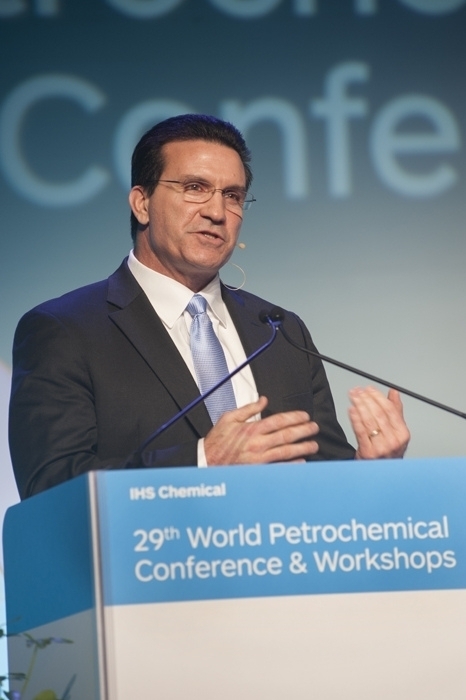April 8, 2016 Updated 4/8/2016
Email Print

IHS Chemical Eramo
Las Vegas — Global commodity resin prices are expected to remain relatively low in the short term, with higher prices possible in 2017 as oil prices begin to recover.
That’s the outlook of Mark Eramo, business development vice president with the IHS Chemical consulting firm in Houston. Eramo spoke April 4 at ISRI 2016, a scrap recycling industry event in Las Vegas put on by the Institute of Scrap Recycling Industries Inc.
Low-priced crude oil and natural gas feedstocks have lowered commodity resin prices since mid-2014. Those drops have made commodity resins “low-priced and available,” Eramo said, and those low prices could provide stimulus for higher demand.
“The world is growing again, but at a slow pace,” he explained. “China is transitioning from manufacturing to a service economy. The U.S. economy will continue to expand at a moderate pace, led by consumer spending and homebuilding.”
IHS expects the U.S. and advanced economies to grow around 2 percent per year through 2020. Emerging markets should average 4 to 6 percent growth in that period, bringing average global GDP growth to just over 3 percent.
“Even though [the global economy] is growing slower than we’d like, it’s still growing,” Eramo said. “People are consuming products and that has tremendous impact on plastics and chemicals.”
Global oil demand growth has slowed as supplies have increased, largely from new U.S. production related to fracking and horizontal drilling. These new supplies have driven prices down from $ 100 per barrel in mid-2014 to less than $ 38 on April 6.
Some oil firms have cut back production as a result. Lower supply and improving world economies should drive oil prices back to $ 60 per barrel during 2017, Eramo said.
In plastics, global overcapacities exist for many commodity resins, due in large part to overbuilding in China. But plastics feedstocks ethylene and propylene are expected to average above GDP growth through 2020, according to Eramo. He also delivered outlooks for major commodity resins.
Polyethylene — with a global market share of 38 percent of the major thermoplastics market in 2015 — should grow at or slightly above global GDP. And even with higher oil prices, major North American PE expansions set for the next 2 to 3 years is expected to outpace demand and could drive prices down.
Polypropylene (26 percent of plastics market share) should grow at above GDP levels through 2020. Supplies of the material are long globally but are short in North America, since numerous assets were closed when the market was oversupplied in 2010-14. As a result, PP is being imported into North America, which could serve to keep prices relatively low.
PVC (18 percent of plastics market share) growth rates are expected to be close to GDP. Major overbuilding of the material in China could create a downside risk in pricing, Eramo added.
PET bottle resin (8 percent of plastics market share) also could see similar GDP-level growth. Recycling has come into play here, according to Eramo, as increased availability of recycled PET has lessened demand for prime grades of the material. Prime PET remains in oversupply in all regions of the world.
Polystyrene (4 percent of plastics market share) growth should be at levels below that of GDP. Eramo described PS as being “under siege” from lower-priced materials, with limited demand growth and no new investment in capacity.
Intermaterial and interpolymer competition also is expected to continue, Eramo said, with global trade patterns leading to more and more cases of resin being consumed outside of the region where it’s produced.
“That’s great news for traders and ship builders,” he added.



























